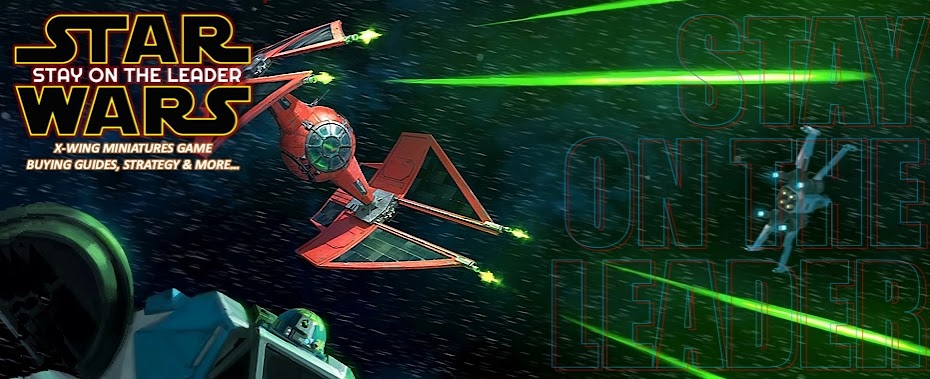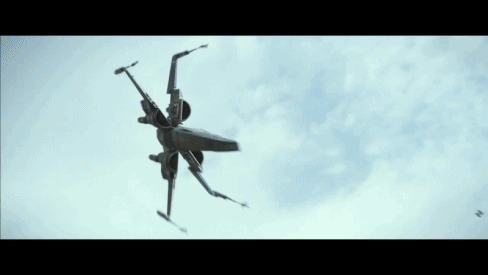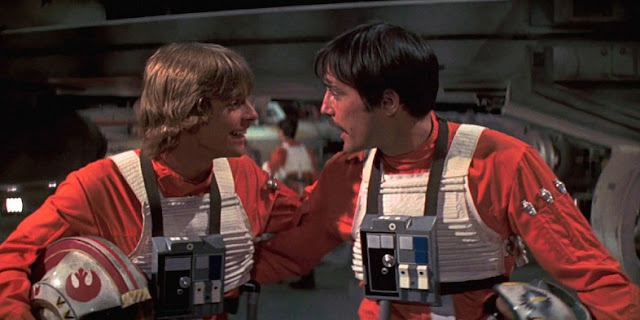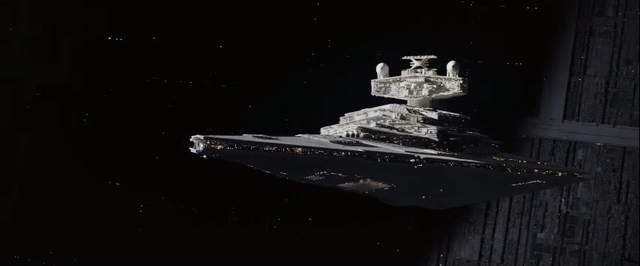There was
a really good blog I read recently by 186th Squadron member Oliver Pocknell, which was all about the importance of getting your target priority right and making sure you kill the right ships first. Target priority is certainly something that can easily win or lose you a game of X-Wing - it can be the difference between facing an endgame monster of a ship at the end of the game in a 1-on-1 duel you can't win, or eliminating it right off the bat while you've got enough guns to make short work of them.
In this blog I'm going to look at the flipside of this equation, though, which is the more subtle art of how you can influence your opponent's target priority to your own benefit! In part this has been inspired by my view of the many different versions of Quickdraw loadouts, and we'll get to him later as a specific example, but it's something that I'm increasingly aware of in virtually all of my squad designs.
Setting The Puzzle
In short, the individual ships in your squad come together to form a target priority puzzle that you're posing to your opponent. Your opponent is trying to unpick where the weak point in your squad is and where the greatest threats are, so that he can get his target priority right. Not only is every every pilot card or upgrade that you add to your squad changing the puzzle you pose, but it's also a puzzle where each individual piece affects how the other pieces are viewed and used in trying to solve it.
Colonel Vessery - Adaptability, TIE/x7, Twin Ion Engine MkII
Quickdraw - A Score To Settle, Fire Control System, Lightweight Frame, Special Ops Training
Backdraft - Veteran Instincts, Primed Thrusters, Fire Control System, Lightweight Frame, Special Ops Training
I think you classify a ship's defensive attributes & performance in four rough categories:

- Endurance - this is a pretty raw measure of just how much damage a ship has to take before it's destroyed (eg. Hull + Shield). It's a passive form of defense that only really works to deter opponents from attacking when the threat the ship poses isn't worth the effort of chewing through the amount of hit points needed to destroy it. Upgrades like Hull Upgrade, Integrated Astromech or Chewbacca crew would fall under this category.

- Resistance - this indicates how good a ship is at 'resisting' or cancelling incoming hits entirely, either through having lots of green dice, defensive tokens or other upgrade effects like C-3PO, Latts Razzi or Autothrusters. I'd also class most shield regeneration effects as Resistance as you're reversing the effects of incmoing damage as though it never occurred. Good Resistance defenses tend to be a better deterrent against attacks than Endurance defenses because the opponent faces a greater risk that his attacks will be entirely wasted.

- Intimidation defenses are relatively rare in X-Wing but there are increasingly examples of ships and upgrades that will punish an opponent for attacking you, like Dengar, Quickdraw, Kylo Ren, Rebel Captive etc. These sort of defenses can be extremely effective at deterring attacks if you can make your ship 'spiky' enough, and especially if it can be paired with Resistance defenses so that an opponent risks dealing no damage and being punished for even daring to try!

- Agility defenses are different to the others in that they're not necessarily properties of the ship's build but also of how you play it on the table. It covers the obvious repositioning abilities of things like Boost and Barrel Roll to avoid being in arc of an opponent, but it also covers the broader art of simply flying ships more defensively - running away from bad situations, hanging back at range 3 or behind asteroids for extra green dice. The amount that your ship wants to use Agility defences is often a result of how strong their other defences are.
So let's look at how this example squad's defenses stack up under these four categories, and I'm going to pretend I'm playing 'Top Trumps' and arbitrarily score them 1-5 on each.
Colonel Vessery has 3 Agility and Focus & Evade tokens thanks to TIE/x7 title, meaning the TIE Defender has very strong Resistance to incoming attacks. Six hull is pretty average for Endurance, and although the Defender is a quick ship with a barrel roll action it's quite predictable if it wants to benefit from that free Evade token so it doesn't naturally use Agility a lot.
Endurance:3, Resistance:5, Intimidation:1, Agility:3 - TOTAL 12
Quickdraw's pilot ability is all about Intimidation, with opponents often very reluctant to try and take a shot at him in case they only succeed in stripping a single shield. That Intimidation is backed by a decent Resistance with 3 green dice (thanks to Lightweight Frame) which are usually focused as Quickdraw has Fire Control System and A Score To Settle to use modifying his attacks. More cumbersome than a TIE Defender, with a bunch of red maneuvers he doesn't want to use as he'll lose his defensive Focus, Quickdraw scores quite badly on Agility.
Endurance:3, Resistance:3, Intimidation:4, Agility:2 - TOTAL 12
Backdraft is a TIE/sf like Quickdraw so most of his defensive attributes are the same. The main difference is that he loses Quickdraw's revenge attack so there's no Intimidation factor. With weaker defenses Backdraft will have to rely on dodging as many shots as possible with his limited Agility, which Primed Thrusters helps with a little, but it's only a marginal benefit.
Endurance:3, Resistance:3, Intimidation:1, Agility:2 - TOTAL 9
Let's return to that original idea of my squad being a 'puzzle' that I'm setting my opponent for him to work out how best to approach a game against me. When you put those three pieces of the puzzle together it turns out I've not really set a particularly difficult challenge because I'm actually 'telling' my opponent to shoot at Backdraft as the other ships in my squad have much better defenses. The damage output from my three ships is very similar so the opponent isn't having to make his decision based on which of my ships are the biggest threat, or the thing he simply can't allow into the endgame, so he can simply chase the softest target.
It meant that I had to take my flying style for Backdraft and artificially fly it more defensively than I otherwise would (let's say I flew it defensively enough to rate as Agility:4) but that this had an impact on how much damage Backdraft was doing.

Time and time again this was what I was finding in my table experience - I would protect Backdraft as much as I could but it would either cost me in shots & damage he was dealing, or I'd misjudge my defensive flying and Backdraft would be wiped off the table relatively early in the game.In another squad, alongside ships that weren't such unappealing targets, Backdraft possibly wouldn't have been such a weak point but in this squad he was giving me a problem.
It was time to explore other options, and I found an answer in an unexpected place:
 Darth Vader - Juke, TIE/x1, Advanced Targeting Computer, Twin Ion Engine MkII
Darth Vader - Juke, TIE/x1, Advanced Targeting Computer, Twin Ion Engine MkII
Vader's double action allows him to have the same Resistance from 3 green dice with Focus and Evade that Colonel Vessery benefits from. He's got one less shield than the TIE Defender so less Endurance but as his defensive tokens aren't tied to any particular moves, and he can Barrel Roll & Evade, he rates more highly on Agility - particularly as I'm going to be playing him quite conservatively.
Endurance: 2, Resistance: 5, Intimidation: 1, Agility:4 - TOTAL 12
What Darth Vader gives me is a third ship that rates very highly on defense and that's going to pose my opponents a less obvious puzzle to solve. In some ways it means there's often not a clear right or wrong answer, but in practice it gives me the opportunity to tag my ships in and out with positioning in order to spread my opponent's fire. For example Vader might get into range 1 and take a shot and lose a couple of shields, but he'll then speed out to Range 3 while Vessery comes into range 1 to take his shot - does my opponent spread his fire between two ships or risk wasting it entirely on Darth Vader with 4 green dice and Focus & Evade?
What's especially interesting in this particular case is that it means I took Darth Vader because of his Resistance score, when classically Vader has been considered to live on his Agility thanks to Engine Upgrade giving him both reposition actions per turn. In my experience of playing with Vader my damage output is overall a bit lower than it was with Backdraft in the team, but because he's not a soft target I'm winning a lot more games 100-0 that I would otherwise have won 100-33 with Backdraft in the team.
Generating Aggro and Holding Threat
Defenses are only one side of the puzzle you're posing to your opponent, though, so let's pick up a different squad of mine as an example of how your Offense can affect the opponent's decisions.
Norra Wexley - Push The Limit, Kyle Katarn, R5-P9, Alliance Overhaul, Vectored Thrusters
Endurance:4, Resistance:3, Intimidation:1, Agility:2 - TOTAL 10
Thane Kyrell - Tactician, R2-D2, Alliance Overhaul, Vectored Thrusters
Endurance:4, Resistance:2, Intimidation:1, Agility:2 - TOTAL 9
Gold Squadron Pilot - R3-A2, BTL-A4
Endurance:4, Resistance:1, Intimidation:1, Agility:1 - TOTAL 7
First off, pretty much across the board you can see that the squad is less weighted towards repelling the opponent's firepower than my Imperial squads are. With more health I've rated the Rebel ships more highly on Endurance, and although they've only got 1 green dice apiece I've rated them a little more strongly on Resistance due to both ARC-170s bringing regeneration astromechs, with Norra picking up another point for the defensive side of her pilot ability. Vectored Thrusters gives them some sort of repositioning so I've said for Agility 2 just to be kind.
Although the overall 'defensive score' is lower the puzzle this squad poses the opponent isn't really about the defense but about how I'm using offense to pull my opponent's attention to where I want to go.
When my opponent looks across the board my biggest damage threat is Norra Wexley as she hits harder than anybody else, and she's also the best endgame ship I have with her combination of regeneration and extra defensive Evades from her ability when I need them. That all makes Norra the obvious first target for my opponent and although I've scored her an arbitrary '10' for her defence so much of that is wrapped up in Endurance, which as I originally explained is most effective as a deterrent when pretty inconspicuous and not worth focusing on. That's not my 40+pt big gun Norra Wexley!
And that's where my Stresshog Y-Wing and Thane come in, because the threat of all those stress tokens pouring out of the rest of my list pulls aggro away from Norra against a huge number of people. That makes the puzzle I'm setting the opponent that much harder to solve because they're balancing many more factors:
- Is there an immediate damage threat?
- Is there something I can't kill 1-on-1 in endgame?
- Is there something I can kill quickly?
Returning to my Imperial squad for another example... let's say I was hypothetically going to replace my TIE/x7 Colonel Vessery with a TIE/D Vessery armed with a Tractor Beam. I don't have the points to do that in my squad, but as we're dealing with hypotheticals lets spend some extra hypothetical points and make it happen anyway.
Colonel Vessery - Adaptability, Tractor Beam, TIE/D, Twin Ion Engine MkII
Endurance:3, Resistance:3, Intimidation:1, Agility:3 - TOTAL 10

What that's creating is now a much simpler puzzle again for my opponent as TIE/D not only knocks Colonel Vessery's Resistance rating down by removing the Evade token but it also makes him a much more tempting target as it's both a bigger damage threat (thanks to Tractor Beam) and a bigger chunk of MOV (3pts more than an /x7 Defender).
And yet there are Imperial squads making good use of TIE/D Defenders so what's going on? Well it's because the pieces have to form a coherent puzzle for the opponent. Drop an offense-weighted TIE/D Defender into a squad that's otherwise about defense and you'll make it a clear first target, but that same TIE Defender in a squad designed to deal maximum damage, say with Quickdraw and Pure Sabacc, and it makes much more sense.
There's yet another good example in recent Imperial squads that's less about what you're asking your opponent to shoot at first and more about the opposite - persuading them NOT to shoot at something first. Omega Leader is a fantastic ship in endgame, which your opponent knows so he's going to try and destroy it first. But if your pair Omega Leader up with some high offense ships then there's a good chance that will draw the enemy's attention away from Omega Leader in the early game.
The end result of all this is that ships/pilots can be perfectly good on their own but your squad as whole may not add up to the sum of its parts. If you've not got a grasp on the puzzle you're posing the opponent then it's very easy to put great pieces together into something that doesn't actually make sense. Instead of working together and complementing each other your squad can be working at cross purposes to each other, leaving you with hard work to do on the table to try and keep everything in line.

There was another great example of this in a squad a friend of mine made the other week. He took the Expertise/K4 Dengar that won Worlds, which is demonstrably a really great ship, and then stripped the torpedoes off it so that he could afford to bring Asajj Ventress with Push The Limit, Latts Razzi and Engine Upgrade, another demonstrably great ship. These two great ships, combined, were basically... it wasn't good. In removing the torpedoes from Dengar my friend had unwittingly reduced the 'Intimidation' factor that was preventing people from just punching Dengar in the face until he was dead, and then although Asajj was incredibly tough with Latts Razzi on board she wasn't actually getting fired at until Dengar was dead, and didn't have enough firepower to draw attention away from her teammate.
Two great ships, one lousy puzzle.
It may not be something that convinces you that you need to change your squad loadout, but understanding what the puzzle is that your opponent is trying to solve will at the very least inform how you fly your ships. In my original example switching in Darth Vader for Backdraft wasn't as simple as a direct 'upgrade', but it was something that came about because I had an understanding that I was having to fly Backdraft very defensively anyway because he was the weakest link in my squad.
The Many Faces of Quickdraw
Finally, I said at the very start of this blog that it was inspired the many different ways I've seen Quickdraw used, and I think you can explain a lot of those changes when you see the rest of the squads that's he's being played in.
All five of these Elite Pilot Talents are commonly equipped to Quickdraw and all have proven successful at various times in various squads. Quickdraw's loadout is having to flex to the ships in his squad and an expectation of whether Quickdraw is going to be an early target for your opponent, in which case a cheap EPT is preferable like Adaptability or A Score To Settle (in itself a great way to play with your opponent's target priority) in order to minimise your early losses. That's what I'm using in my 'Nettling Imps' squad and I know a few players have picked my squad up as a base, with at least one of them finding success and winning two store championships in recent weeks with a slightly modified version...
- Quickdraw - Adaptability, Fire Control System, Lightweight Frame, Special Ops Training (33)
- Backdraft - Veteran Instincts, Fire Control System, Lightweight Frame, Special Ops Training (32)
- Colonel Vessery - Juke. TIE/x7 (35)

In other squads where you think your opponent is going to have other targets in the early game then it came make sense to really maximise Quickdraw and spend more points as he is a safer place to put that investment. Those are the builds that might decide to load up on something like Expertise & Pattern Analyser, or even the more aggressive Homing Missile & Guidance Chips.
- Quickdraw - Expertise, Fire Control System, Sensor Cluster, Lightweight Frame, Special Ops Training (39)
- Pure Sabacc - Veteran Instincts, Adaptive Ailerons (23)
- Colonel Vessery - Juke. TIE/x7 (35)

And finally if the rest of your squad is really aggressive and drawing attention from Quickdraw you might decide you want to be able to force your opponent into triggering Quickdraw's second attacks! That mean either using the combination of Rage and Electronic Baffle to remove your own shields, or by using Draw Their Fire to protect a more vulnerable colleague by sucking damage onto Quickdraw.
When Lukasz Golonka took Quickdraw into 3rd at the Lothal Open earlier this year he was so confident that his opponent would be targeting the huge threats from rest of the squad that he could play a dedicated 'support' loadout with Targeting Synchroniser and Draw Their Fire, and didn't even spend points on Lightweight Frame!
- Quickdraw - Draw Their Fire, Fire Control System, Targeting Synchroniser, Special Ops Training (35)
- Carnor Jax - Veteran Instincts, Royal Guard TIE, Autothrusters, Hull Upgrade (32)
- Tomax Bren - Crack Shot, Ion Pulse Missiles, Concussion Missiles, Extra Munitions, Guidance Chips (35)
What the many faces of Quickdraw do is demonstrate perfectly how important it is to strike the right balance between the parts of your squad to set the opponent the toughest puzzle possible. Mix these pieces up between their respective squads and they wouldn't work anywhere near as well. It's the same pilot, and in most of the cases many of the upgrade cards are the same, but Quickdraw is a fascinating example to me of how just changing a single EPT slot can make him fit into different roles for the squads he's a part of.
It's something I'm aware of more and more when I look at successful squads, such as the Norra/Shara/Jess list that John Proctor won Stele Open with, where the switch from R2-D2 to BB-8 on Norra was not exposed as a weakness because he had both Jess Pava drawing aggro with her Stressbot and Shara Bey contributing Evade tokens with Jan Ors. Another great example of a squad that understands what it's telling the opponent to do and trying to use that to it's advantage.
Understand your squad, and understand what it looks like from across the table. It will help you to load it out correctly, and it will also help you to fly it correctly. Take control of the puzzle you're setting for the opponent and success will come more easily.





















































